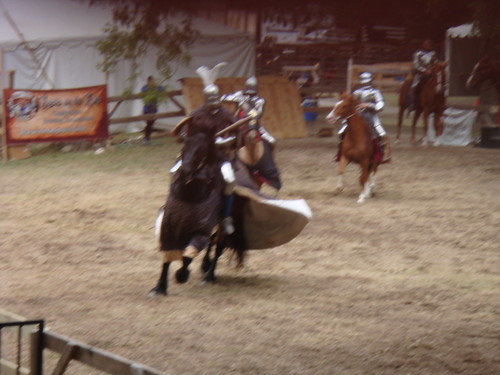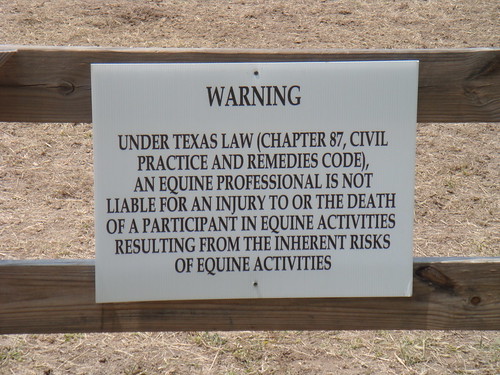To expand on yesterday's teaser post, my son and I got up early Saturday morning and hit the road for Austin, to see the Lysts on the Lake jousting tournament. This was not a renaissance fair or a staged stunt show, but an an actual competition jousting tournament, held on the shores of Lake Travis. More properly, it was held on the property of Richard Garriott, video game gazillionaire, private astronaut, and ubergeek extraordinary. A long-time friend of the local Society for Creative Anachronism group, Mr. Garriott has transformed his property into a nearly ideal venue for an SCA tourney, complete with a "village" of buildings suitable for camping, a "castle," a "pirate ship," and, most impressively, an Elizabethan style theater building (he sponsors a local theatrical company called "The Baron's Men," who produce Shakespeare's works in a proper venue). In short, it's almost like his own little campaign setting writ large.
But enough about the setting. Let's talk about the deeds we saw and a bit about how they can fit into a gaming context. The complete set of photos I took at is here. They are arranged chronologically, so that's how I'll approach my commentary. You can open another window and follow along.
The first few photos are of horses and preparation. I love heavy horses, and there were some absolute beauties on display. Of course, the medieval destrier is long-extinct, but jousting enthusiasts, in the spirit of re-enactors everywhere, simply make their own, generally by crossbreeding thoroughbreds with a modern draft breed. I saw a Belgian-Thoroughbred cross, and a Thoroughbred-Percheron cross that I know of for sure, and I've no doubt many of the other big ones were of similar breeding.
The day's first event was a procession led by musicians, and the Grand Melee a Cheval (literally, "Big Melee with Horses"). This consisted of all sixteen entrants in the tournament on the field at once, armed with wooden clubs. When the signal was given, it was every man (and woman) for him/her self. The object is to be the last one standing who hasn't either been struck five solid blows with the club, been disarmed, or unhorsed (and one rider did, in fact, take a tumble, but his armour protected him from injury). Of all I saw, I found this the most fascinating and the closest to its medieval roots (the rules came straight out of King Rene of Anjou's book of the tournament). Because it's everyone for himself, it very quickly turns into an exercise of opportunism and situational awareness, coupled with a bit of on the spur wheeling and dealing and betrayal. More than once, I saw an unwary rider clocked from behind, and saw others warily stalking around the periphery of the scrum, waiting for a chance to charge in and clip someone from surprise. Finally, three riders remained, and a three way dance ensued, as one rider would commit to the attack, only to find themselves outnumbered. When two remained, they held station and traded blows until finally one triumphed.
In a gaming context, it reminded me of how small a role the "fog of war" plays in our combats. Rarely do players have imperfect knowledge of a combat situation, and the GM never does. I know our Pathfinder and 4e sessions are full of pauses while players figure out the "perfect" tactical placement for their characters each round and an erroneous move is immediately caught and called out by someone else at the table. The challenge is seldom knowing the correct move, and more about figuring out how to make it. As a result, it's very difficult to portray the hurly-burly of battle in any meaningful way. One of the few RPGs I know of that addresses this is Pendragon, which includes a Battle skill to cover any sort of mass combat situation, to reflect the fact that handling yourself in a melee is very different from a one-on-one fight.
Anyway, after that, the Boy and I wandered around the property a bit, visited with some old friends, and explored the castle and the view from same. The picture of the "pirate ship" is taken from a gallery over the main gate and shows how commanding a view one has even from a very small
Next up was a demonstration of armoured foot combat (harnischefechten) by members of the Chivalric Fighting Arts Association. While it wasn't a competition per se, it wasn't staged either. I'm acquainted with a couple of the participants, and know they were fighting as full out as they could safely. They demonstrated a number of weapons forms (longsword, spear, poll-axe, and dagger) in proper plate armour. The latter bit is an important consideration, as they fight under the assumption that armour works. As a result, only hits to unarmoured or lightly-armoured areas counted. As you can see from the photos, grappling and throwing play as large a part as skill with weapons. Again, this is something you just don't see in an RPG environment. Unfortunately, this one is a lot harder to implement in a meaningful way. But, the pictures provide some lovely visuals (the guy in black and red is going to serve a character portrait for my new Pathfinder guy).
After a brief lunch break, it was time for the main event: the first round of jousting. Eight of the sixteen competitors participated, drawn into two groups. Each rider made three passes against each rider from the other group. Points are scored not for unhorsing an opponent, but for hitting with the lance, hitting the opponent's shield, breaking a lance, and breaking more than 50% of a lance. Thus, it's entirely possible for each rider to score a maximum of 4 points on a single pass.
A word about the lances: They consist of three individual parts. The grips are quite sturdy and incorporate a socket into which is fitted the lance tip, a four foot long section of balsa wood, which is slotted to encourage it to split. The tip is fitted with a coronel, a three pronged tip, which blunts the end and provides a degree of purchase on the shield or armour of the target.
As for the jousting itself, in a word: wow. There is something primal about the thump of hooves shaking the ground. The still photos really don't do it justice. We shot video, but need to try to get it pared down to manageable chunks before I can try to put it up online, so you'll just have to trust me on this one.
Or, you can trust this:
From a gaming perspective, I got some interesting fodder. For one thing, as was pointed out several times, the horses were REALLY into this. They are spirited beasts that clearly enjoy running full tilt like that. As a result, often the passes began when one horse started bolting down the lane and the other rider spurred his to get going. In gaming, it's easy to think of mounts as an extension of the rider, but the actual relationship is far more complex and unpredictable. Although no rider was unseated (this is a GOOD THING), there was impact where one was rocked violently in the saddle, which left no doubt about the violence of the sport (it was pointed out that the combined speed at the point of impact is about 60 mph). And finally, to realize the rider is holding the tip of an eleven foot lance on target, at a canter, while looking through an eyeslot an inch or less wide really puts in perspective the level of skill and courage needed to do this well as a hobby, much less as the trained professional that was a medieval knight.
Word is they're planning on doing this again next year. If they do, I know where I'll be.


Holy wow that is one heck of a warning sign! I am so glad you and your son had a great day. Very nice!!!!
ReplyDeleteYeah, I love that sign. I think it normally applies to rodeos as opposed to jousts.
ReplyDeleteThanks a lot for taking the time to put the pictures and description up!
ReplyDelete